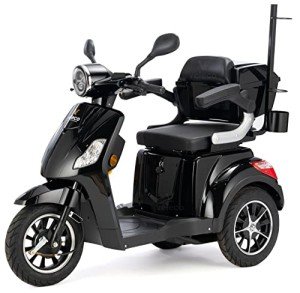A Comprehensive Guide to Buying a Mobility Scooter
Mobility scooters have become a crucial tool for lots of people wanting to enhance their independence and mobility. With a huge array of designs and features offered, choosing the right mobility scooter can be intimidating. This short article provides an informative guide to help consumers navigate their options, examine their requirements, and make an informed purchase.
Understanding Mobility Scooters
Mobility scooters are electric cars designed for individuals who experience mobility difficulties. They are especially helpful for seniors, those with specials needs, or people recuperating from injuries. Mobility scooters can vary commonly in terms of style, features, and rates.
Kinds Of Mobility Scooters
Before starting a purchase, it's necessary to understand the different types of mobility scooters available:
Three-Wheel Scooters:
- Generally more maneuverable in tight areas
- Lightweight and portable
- Perfect for indoor usage
Four-Wheel Scooters:
- Offer greater stability and balance
- Appropriate for outdoor usage over various surfaces
- Usually have a longer battery life
Foldable/Portable Scooters:
- Designed to be easily transported and saved
- Can often suit the trunk of a car
- Suitable for those who travel often
Durable Scooters:
- Built to accommodate bigger individuals
- Often come with more robust functions for outdoor usage
- Usually equipped with bigger batteries for prolonged range
Factors to Consider When Buying a Mobility Scooter
1. Weight Capacity
Select a mobility scooter that can support the user's weight. A lot of scooters have a weight limitation ranging from 250 to 500 pounds. mobility scooters for sale is important to guarantee that the scooter can accommodate the user comfortably.
2. Variety and Battery Life
The range is how far the mobility scooter can travel on a single charge. Typical varieties vary in between 10 to 30 miles. Think about the user's everyday activities and select a scooter with a suitable variety.
3. Scooter Dimensions
Think about the size of the scooter, including its weight and dimensions. A more compact scooter may be ideal for narrow hallways and tight areas, while bigger designs use extra stability and convenience.
4. Terrain Capability
Examine where the scooter will mainly be utilized. If the user prepares to travel primarily on pavement, a lightweight design might be sufficient. Nevertheless, if the user requires to traverse gravel or uneven surfaces, think about a four-wheel scooter built for off-road usage.
Top Features to Look For
Comfort
- Adjustable Seats: Look for scooters with cushioned and height-adjustable seats to guarantee comfort during travel.
- Armrests: These improve security and assistance while navigating.
Safety and Visibility
- Headlights and Taillights: Essential for nighttime use.
- Turn Signals and Reflectors: Improve visibility and security while on the roadway.
User-Friendly Controls
- Joystick or Drive Controls: These ought to be intuitive and simple to control.
- Easy-to-Read Displays: A control panel that shows battery life, speed, and distance can improve the user experience.
Additional Features
- Storage Compartments: These use included benefit for bring individual products while on the go.
- Weather condition Protection: Consider models with rain covers or windshields if utilized in variable weather condition conditions.
Cost Considerations
When budgeting for a mobility scooter, rates can range anywhere from ₤ 500 to over ₤ 5,000 depending on the design, functions, and brand. Extra expenses may consist of:
- Extended Warranty: Protects versus defects and can conserve money in the long run.
- Devices: Optional features, such as updated seats, lights, or storage services.
| Function | Cost Range |
|---|---|
| Fundamental Models | ₤ 500 - ₤ 1,500 |
| Mid-Range Models | ₤ 1,500 - ₤ 3,000 |
| High-End Models | ₤ 3,000 - ₤ 5,000 |
Funding Options
Lots of retailers offer financing plans, and some city government efforts might provide grants or assistance for those in requirement. Examine possible monetary support with neighborhood resources or mobility service companies.
FAQs about Buying a Mobility Scooter
What is the difference in between a mobility scooter and a wheelchair?
Mobility scooters are motorized and permit users to browse independently, while wheelchairs may require physical help or manual operation.
How do I maintain a mobility scooter?
Routine upkeep includes checking battery life, cleaning the scooter, and inspecting tires and brakes. Constantly refer to the user handbook for particular guidelines.
Can mobility scooters be used indoors?
Yes, lots of designs are designed for both indoor and outside usage. Nevertheless, three-wheel scooters tend to be better suited for indoor navigation due to their tighter turning radius.
Are mobility scooters covered by insurance?
Some insurance coverage plans cover a part of the expenses for mobility scooters if they are considered clinically essential. Contact your provider for specific details.
How quick can a mobility scooter go?
Many mobility scooters have a maximum speed varying from 4 to 8 mph. Nevertheless, the proper pace may vary depending on regional guidelines.
Getting a mobility scooter can considerably improve one's independence and lifestyle. By comprehending the types, features, and costs connected with mobility scooters, potential buyers can make educated decisions that match their requirements and choices. Personalization and comprehensive research study are essential to making sure complete satisfaction with this important investment.

